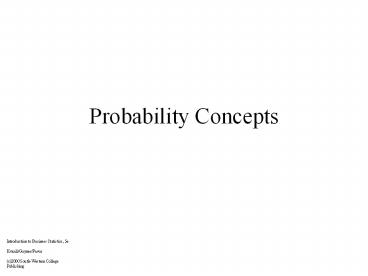Probability Concepts - PowerPoint PPT Presentation
Title:
Probability Concepts
Description:
Probability Concepts Introduction to Business Statistics, 5e Kvanli/Guynes/Pavur (c)2000 South-Western College Publishing Events and Probability An activity for which ... – PowerPoint PPT presentation
Number of Views:240
Avg rating:3.0/5.0
Title: Probability Concepts
1
Probability Concepts
Introduction to Business Statistics, 5e
Kvanli/Guynes/Pavur (c)2000 South-Western
College Publishing
2
Events and Probability
- An activity for which the outcome is uncertain is
an experiment. - An event consists of one more possible outcomes
of the experiment.
Introduction to Business Statistics, 5e
Kvanli/Guynes/Pavur (c)2000 South-Western
College Publishing
3
Relative Frequency Approach
Introduction to Business Statistics, 5e
Kvanli/Guynes/Pavur (c)2000 South-Western
College Publishing
4
Datacomp Survey
M a male is selected F a female is
selected U the person selected is under 30 B
the person selected is between 30 and 45 O
the person selected is over 45
Introduction to Business Statistics, 5e
Kvanli/Guynes/Pavur (c)2000 South-Western
College Publishing
5
Marginal Probability
Marginal Probability the probability of a single
event used to define the contingency table. P(M)
120/200 .6 P(F) 80/200 .4 P(U)
.5 P(B) .25 P(O) .25
Introduction to Business Statistics, 5e
Kvanli/Guynes/Pavur (c)2000 South-Western
College Publishing
6
Complement of an Event
- The Complement of an event A is the event that A
does not occur. ? - P(A) P(?) 1
- P(M) 1 - P(M) .4
Introduction to Business Statistics, 5e
Kvanli/Guynes/Pavur (c)2000 South-Western
College Publishing
7
Joint Probability
- The probability of the occurrence of two events
at the same time. - The probability of selecting a person who is a
female and under 30 - P(F and U) 40/200 .2
Introduction to Business Statistics, 5e
Kvanli/Guynes/Pavur (c)2000 South-Western
College Publishing
8
Union of Events
- The Union of events is the probability of either
event A or event B occurring. - The probability of selecting a person who is
Male or under 30. - P(M or U) (120 40) / 200 .8
Introduction to Business Statistics, 5e
Kvanli/Guynes/Pavur (c)2000 South-Western
College Publishing
9
Conditional Probability
- Whenever you are given information and are asked
to find a probability based on this information,
the result is a Conditional probability. - P(AB)
Introduction to Business Statistics, 5e
Kvanli/Guynes/Pavur (c)2000 South-Western
College Publishing
10
Independent Events
- If the P(A) P(AB) then event A is said to be
independent of event B. - P(M) P(MU) .6
- Thus event M is independent of event U.
Introduction to Business Statistics, 5e
Kvanli/Guynes/Pavur (c)2000 South-Western
College Publishing
11
Mutually Exclusive Events
- If an event can not occur when another event has
occurred the two events are said to be Mutually
Exclusive. - Selecting a Male and a Female are mutually
exclusive events. - P(MF) 0
Introduction to Business Statistics, 5e
Kvanli/Guynes/Pavur (c)2000 South-Western
College Publishing
12
Additive Probability Rules
- General Additive Rule
- P(A or B) P(A) P(B) - P(A and B)
- Special Additive Rule
- If A and B are mutually exclusive then
- P(A or B) P(A) P(B)
Introduction to Business Statistics, 5e
Kvanli/Guynes/Pavur (c)2000 South-Western
College Publishing
13
Conditional Probability Rules
- General Conditional Probability Rule
- P(AB) P(A and B) P(B) ? 0
- P(B)
- Special Conditional Probability Rule
- If A and B are independent then
- P(AB) P(A) P(A and B) P(A) ?P(B)
Introduction to Business Statistics, 5e
Kvanli/Guynes/Pavur (c)2000 South-Western
College Publishing
14
Tree Diagrams
- The probability of the event on the right side
(say, event B) of the tree is equal to the sum of
the paths that is, all probabilities along a
path leading to event B are multiplied, and then
summed over all paths leading to B.
Introduction to Business Statistics, 5e
Kvanli/Guynes/Pavur (c)2000 South-Western
College Publishing
15
Figure 4.11
Introduction to Business Statistics, 5e
Kvanli/Guynes/Pavur (c)2000 South-Western
College Publishing
16
Counting Rules
- Counting Rules determine the number of outcomes
that exist for a certain broad range of
experiments. - Filling Slots
- Permutations
- Combinations
Introduction to Business Statistics, 5e
Kvanli/Guynes/Pavur (c)2000 South-Western
College Publishing
17
Filling Slots
- Use counting rule 1 to fill k different slots.
Let - n1 the number of ways to filling the first slot
- n2 the number of ways to filling the second
slot after the first slot is filled - ?
- nk the number of ways to filling the kth slot
after slots 1 though k - 1 - The number of ways of filling all k slots is
- n1 ? n2 ? n3 ? ? nk
Introduction to Business Statistics, 5e
Kvanli/Guynes/Pavur (c)2000 South-Western
College Publishing
18
Permutations
- Permutations is the counting situation in which
you select people without replacement and where
order of selection is important.
Introduction to Business Statistics, 5e
Kvanli/Guynes/Pavur (c)2000 South-Western
College Publishing
19
Combinations
- Combinations is the counting situation in which
you select people without replacement and where
order of selection is not important.
Introduction to Business Statistics, 5e
Kvanli/Guynes/Pavur (c)2000 South-Western
College Publishing































